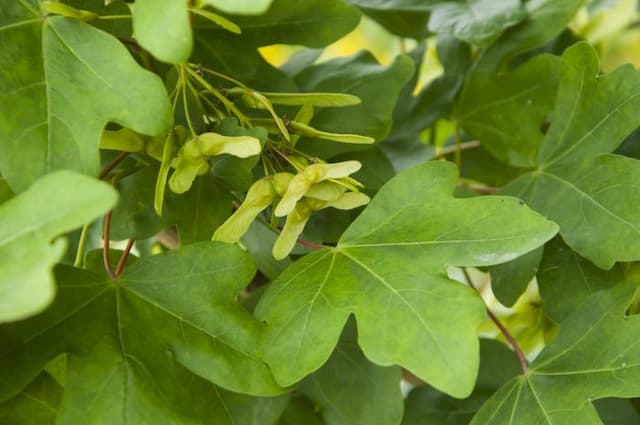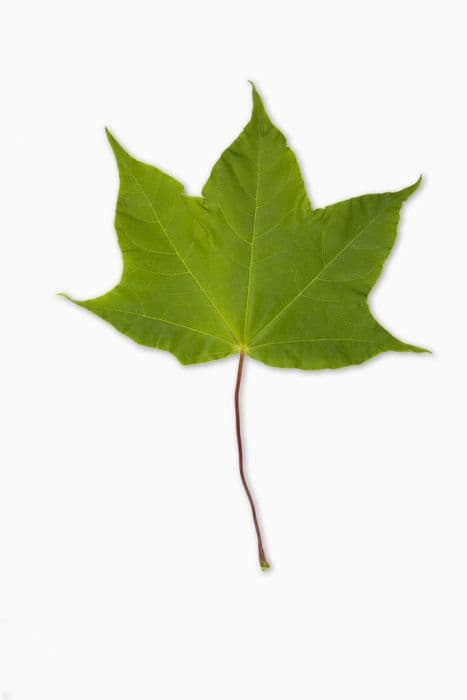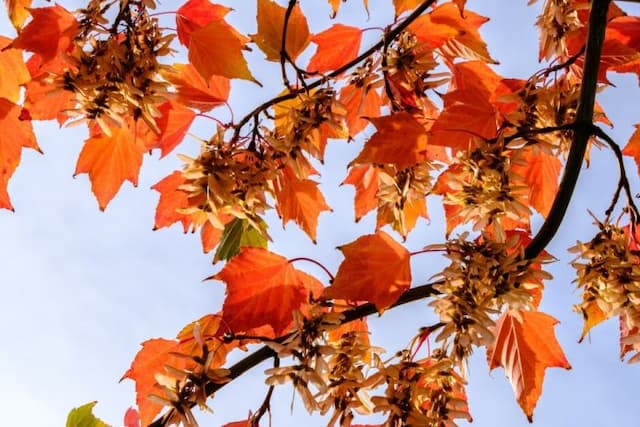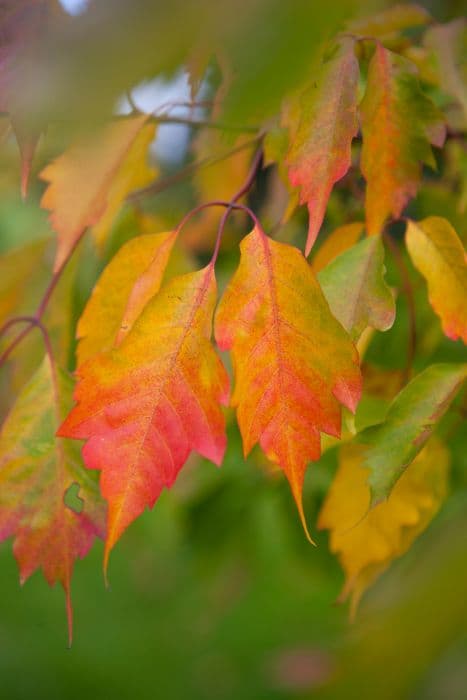Horse Chestnut Aesculus hippocastanum 'Monstrosa'

ABOUT
The horse chestnut 'Monstrosa' is known for its distinctive appearance, with large, broad leaves that are deep green and are palmately compound, meaning they radiate from a central point like the fingers on a hand. Each leaflet is somewhat oblong, with a pointed tip and a serrated edge, giving the foliage a lush, dense appearance. When blooming, the horse chestnut 'Monstrosa' displays upright clusters of flowers, also known as panicles, which can be quite showy. The flowers are usually white with a splash of pink or yellow at the base of each petal, adding a splash of color against the green foliage. As the flowering season ends, the tree develops its notable fruit: a spiny, green capsule containing one or more large, shiny, brown seeds that are often called conkers. The bark of this tree is dark gray and textured with ridges and furrows, adding to the tree's overall majestic and robust look.
About this plant
 Names
NamesSynonyms
Horse Chestnut, Conker Tree.
Common names
Aesculus hippocastanum 'Monstrosa'.
 Toxicity
ToxicityTo humans
The common name of Aesculus hippocastanum 'Monstrosa' is Horse Chestnut. Parts of the Horse Chestnut, including seeds, leaves and bark, are toxic to humans if ingested. The toxic substance in this plant is called aesculin, which is found in all parts of the plant but most concentrated in the seeds. Symptoms of Horse Chestnut poisoning may include nausea, vomiting, diarrhea, abdominal pain, dizziness, and in severe cases can lead to kidney damage, muscle twitching, loss of coordination, paralysis, and circulatory and respiratory failure.
To pets
The common name of Aesculus hippocastanum 'Monstrosa' is Horse Chestnut. It is toxic to pets such as dogs, cats, and horses. Ingesting any part of the Horse Chestnut plant can cause symptoms of poisoning in pets, which might include vomiting, diarrhea, depression, weakness, dilated pupils, paralysis, and can be fatal if not treated. Contact a veterinarian immediately if you suspect your pet has consumed any part of a Horse Chestnut tree.
 Characteristics
CharacteristicsLife cycle
Perennials
Foliage type
Deciduous
Color of leaves
Green
Flower color
White
Height
50 feet (15.24 meters)
Spread
40 feet (12.19 meters)
Plant type
Tree
Hardiness zones
5
Native area
Southeast Europe
Benefits
 General Benefits
General Benefits- Shade: The Horse Chestnut 'Monstrosa' provides ample shade due to its broad canopy, making it ideal for parks and large gardens.
- Ornamental value: With its large, palmate leaves and showy, white flower spikes, this tree has significant ornamental appeal.
- Habitat for wildlife: It offers a habitat and food source for a variety of wildlife, including bees and other pollinators attracted by its flowers.
- Soil stabilization: The extensive root system helps prevent soil erosion, making it valuable for planting in areas susceptible to this problem.
- Seasonal interest: Horse Chestnut 'Monstrosa' provides year-round interest with changing foliage, flowers in spring, and conkers in autumn.
 Medical Properties
Medical Properties- Venous insufficiency: Extracts from the common horse chestnut, which is the species Aesculus hippocastanum, have been used to treat chronic venous insufficiency.
- Anti-inflammatory effects: The seed extract of horse chestnut may exhibit anti-inflammatory properties, which can contribute to reducing swelling and pain in conditions associated with poor blood circulation.
- Edema: The plant is sometimes used to reduce edema, which is the swelling caused by excess fluid trapped in the body's tissues, particularly in the legs.
- Hemorrhoids: Due to its vein-strengthening and anti-inflammatory effects, it is sometimes used to address the discomfort associated with hemorrhoids.
- Varicose veins: Horse chestnut seed extract has been traditionally used to relieve symptoms of varicose veins, including pain, tiredness, and swelling.
 Air-purifying Qualities
Air-purifying QualitiesThis plant is not specifically known for air purifying qualities.
 Other Uses
Other Uses- Water purification: The seeds contain saponins, which can be used for cleaning and as a natural surfactant to remove impurities from water.
- Photographic film: The high starch content in horse chestnut seeds can be used in the preparation of certain types of photographic films.
- Laundry detergent: Saponins from the seeds may serve as a natural soap for laundering fabrics.
- Animal feed: The seeds can be processed to remove toxins and then used as feed for livestock.
- Bioplastic production: The starch from horse chestnut seeds can be used in the development of biodegradable plastics.
- Gardening: The spiny outer capsule of the seeds can deter pests or be used as a natural mulch to protect soil moisture levels.
- Fish poison: Historically, saponins from the tree were sometimes used to stun or kill fish, making them easier to catch.
- Conkers: The hard seeds are used in the game of conkers, where two players swing horse chestnut seeds on strings to break each other's seed.
- Leather tanning: The tannins present in the bark can be extracted and used in the leather tanning process.
- Furniture polish: The conkers can be crushed and mixed with wax to create a natural furniture polish.
Interesting Facts
 Feng Shui
Feng ShuiThe Horse Chestnut is not used in Feng Shui practice.
 Zodiac Sign Compitability
Zodiac Sign CompitabilityThe Horse Chestnut is not used in astrology practice.
 Plant Symbolism
Plant Symbolism- Strength and Stability: The Horse Chestnut tree, common name of Aesculus hippocastanum 'Monstrosa', is known for its sturdy trunk and branches, symbolizing strength and steadfastness.
- Protection: In folk traditions, Horse Chestnut was believed to ward off negative energy and protect against lightning, hence symbolizing protection and safety.
- Health and Healing: Historically, Horse Chestnut seeds were used for their medicinal properties, representing health and the power to heal.
- Fertility and Abundance: With its prolific seed production, the Horse Chestnut has been seen as a symbol of fertility and abundance.
- Endurance: Its ability to resist harsh conditions symbolizes endurance and the ability to withstand life's challenges.
- Prosperity: The bountiful seeds are also associated with prosperity, reflecting a wish for wealth and success.
 Water
WaterHorse chestnut trees, including the 'Monstrosa' variety, prefer to be watered deeply and infrequently to encourage strong root development. Typically, mature trees will need water every couple of weeks, with about 1.5 to 2 inches of water, which is approximately 10-15 gallons for a young tree and up to 100 gallons for a mature tree, depending on its size and the weather. During the growing season in spring and summer, watering should be done more frequently, especially if the weather is particularly dry or hot. Make sure to water the soil around the tree rather than the foliage to reduce the risk of disease, and always allow the soil to dry out slightly between waterings.
 Light
LightThe Horse chestnut 'Monstrosa' thrives best in full sun to partial shade. It should be planted in a location where it can receive at least four to six hours of direct sunlight daily. However, in very hot climates, some afternoon shade can be beneficial to prevent scorching. An ideal spot would be one that enjoys morning sunlight with some protection from the intense afternoon sun.
 Temperature
TemperatureHorse chestnut 'Monstrosa' trees are hardy and can tolerate a wide temperature range. They can withstand winter cold down to about -20°F and are suited for USDA Hardiness Zones 3 through 8. However, they grow best in areas where summer temperatures do not often exceed 90°F, and they prefer a moderate climate with distinct seasons. Ideally, during the growing season, temperatures between 60°F and 80°F are most favorable for healthy growth.
 Pruning
PruningPruning the Horse chestnut 'Monstrosa' is mainly for aesthetic shaping and the removal of dead or damaged branches. It's best to prune during the dormant season, in late winter or very early spring before new growth begins. Light pruning can be done to maintain a pleasing shape, and it is generally recommended to prune no more than a quarter of the crown in a single year to avoid stress to the tree.
 Cleaning
CleaningAs needed
 Soil
SoilThe Horse Chestnut 'Monstrosa' prefers well-drained soil with consistent moisture and a pH range of about 6.0 to 7.5. For an optimal soil mix, combine loamy soil with organic compost and a small portion of sand to ensure good drainage.
 Repotting
RepottingHorse Chestnut 'Monstrosa' trees do not need regular repotting as they are large, slow-growing trees typically planted outdoors. Repotting is usually not applicable for this species.
 Humidity & Misting
Humidity & MistingHorse Chestnut 'Monstrosa' tolerates a wide range of humidity levels and does not require any specific humidity conditions when planted outdoors in its natural environment.
 Suitable locations
Suitable locationsIndoor
Not suitable for indoor growing; it's a large outdoor tree.
Outdoor
Plant in well-drained soil, full sun to partial shade, water regularly.
Hardiness zone
3-8 USDA
 Life cycle
Life cycleAesculus hippocastanum 'Monstrosa', commonly known as the Horse Chestnut 'Monstrosa', begins its life cycle with seed germination, typically in the spring, after a period of dormancy and stratification to break seed dormancy. Following germination, the seedling grows into a young sapling, establishing a root system and producing its characteristic palmately compound leaves. As it matures into an adult tree, the Horse Chestnut 'Monstrosa' develops a distinctive, often twisted trunk and a spreading canopy, and it starts flowering, generally around 7-8 years after planting, with large white, pink, or red flowers in conical panicles. After flowering, the tree produces its fruit, a green, spiky capsule containing one to three large, shiny brown seeds known as conkers. The tree continues to grow and can live for decades, entering a period of senescence as it ages, which is characterized by reduced growth and productivity before eventually dying. During its lifetime, the Horse Chestnut 'Monstrosa' will undergo periodic cycles of growth, reproduction, and dormancy, typically marked by annual leaf drop in the autumn and new growth in the spring.
 Propogation
PropogationPropogation time
Spring to Summer
One of the most popular methods of propagating the Horse Chestnut or Conker tree (Aesculus hippocastanum 'Monstrosa') is by seed. The optimal time for sowing Horse Chestnut seeds is in the fall, immediately after collection. This timing allows the seeds to undergo a natural stratification process over winter, which is necessary for breaking seed dormancy. To propagate by seed, collect ripe conkers and plant them about 2 inches deep in a well-draining soil mix. It is recommended to sow them in pots or a nursery bed, where they can be monitored and protected from rodents. After the cold stratification period provided by winter, seeds usually germinate in the spring. However, be aware that trees grown from seed may not retain the exact characteristics of the 'Monstrosa' cultivar.









